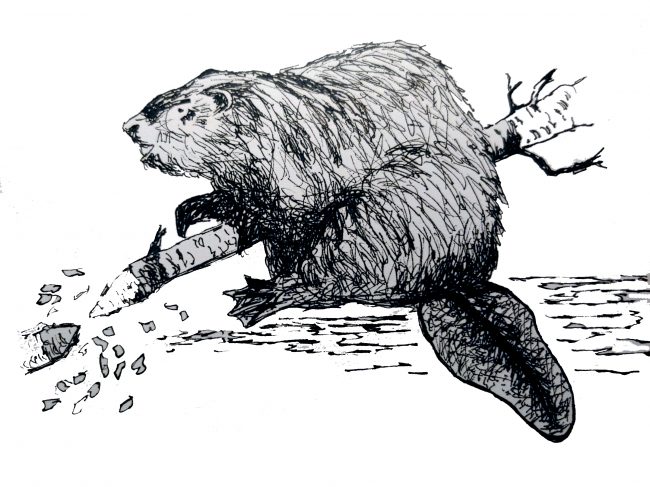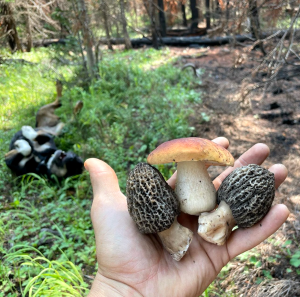WE DO NOT DESERVE BEAVERS.
Well, OK. American beavers can be complicated neighbors. They sometimes interfere with our plans, tunneling into canal banks, flooding farmers’ fields and blocking and rerouting waterways. They can destroy infrastructure and take down power lines. They harvest landscape plantings. But oh, the beneficial things they do for us while they are just living their lives: water engineers, species diversity managers, firefighters, Superfund clean-up technicians … .
Across North America, hundreds of millions of American beavers once felled trees and dammed waterways. But beginning in the 17th century, the fur trade wiped out nearly 90% of this mammal’s population because its dense fur produced an excellent hatter’s felt (the material used for men’s hats). The beaver dodged extinction in the mid-19th century by a shift in the fickle fads of fashion: Chinese silk replaced beaver felt as the material of choice for gentlemen’s hats. Thanks to significant reintroductions beginning in the mid-1900s, the beaver population is slowly rebounding. Today, 10-15 million beavers call this continent home. And thanks to its streams, rivers and lakes, Colorado hosts a robust beaver population, although numbers are tough to estimate.
Among the largest living rodents, beavers are swimming mammals the size of basset hounds with an obsession for manipulating running water by building dams. The ears are short and rounded; the blackish to dark brown fur has long, shiny guard hairs and dense, soft, waterproof underfur. The legs are short; the hind feet, webbed; and the small forepaws, surprisingly dexterous. The broad, flat, scaly tail functions as a rudder, an assist with balance on land and a lever in dam construction. The orange and ever-growing front incisors must be kept trimmed by continually gnawing — primarily trunks (preferably 6-inch diameter or less) and branches. Plus, those trunks and branches become both building materials and food. The preferred staples of beavers’ diets in Colorado are bark, buds, leaves and twigs of aspen, willows and cottonwoods.

Before we go any further, let’s make a distinction between beavers and muskrats. Both are semi-aquatic, inhabit Colorado, swim well and build structures that allow them to live in ponds. However, the most striking difference lies in their tails — beaver tails are wide and flat; muskrats’, long and skinny. When swimming, muskrats swim high in the water, so you can usually see their whole bodies; with beavers, you often only see their blocky, wedge-shaped heads above the water. Beavers are also larger than muskrats — 35-60 pounds versus a mere 4 pounds. But that comparison doesn’t help unless you see them both together, which doesn’t happen often. Their shelters look different too: A beaver lodge consists of twigs and branches held together with lots of mud; muskrats pile plants (e.g., leaves, cattails) over a firm base such as a tree stump, using just a small amount of mud to hold things in place. And only beavers build dams.
Beavers gnaw down trees and branches around their territory and drag them to their building location, whether for a dam or a lodge. Their powerful jaws and chisel-like incisors break everything into smaller pieces, and the beavers start making construction piles. Then they use their front paws to squish mud between the pieces. They smack the logs and mud with their tails to make sure the entire construction is sturdy.
Beavers design their lodges with several inside features above the water level: a ledge for food storage during colder months, a sleeping area, an air vent to help keep the lodge cool during the hot summer days and two underwater entrances leading inside the lodge so they can escape predators. Even in the coldest pond covered with ice, the beavers often keep a hole open in the ice near the dam in case they need to tend it to keep the water levels up.
In Colorado, you can spot beavers’ handiwork in a number of places. Beavers occur statewide in suitable habitat, marked by adequate supplies of water and food. In Central Colorado, you could check out the road to O’Haver Lake, around the base of Huron Peak, or along the Greens Creek Trail for beaver ponds. The Kenosha Pass area has had an extensive network of beaver ponds for years too — search online for “Kenosha Pass, beaver ponds, YouTube” for a lovely video of some ponds from one person’s GoPro. Really though, any time you drive along a wooded creek, you might spot one.
Beavers do more to shape their environments than nearly any other wild creatures on the planet. They excel as water engineers, building dams and complex canal systems to provide shelter, regulate water levels and create waterways for floating food and construction materials to a pond. On land, with their unwieldy tails and awkward waddle, beavers make easy targets for coyotes and bobcats. Coupled with the canals and ponds, their semi-aquatic lives keep them safer.
Beavers are considered a keystone species. Through their constructions, they modify the environment in ways that support the presence of other species (like the keystone of an arch holds the other stones in place). Deep pools and shallow spots, fast and slow water all mix together, inviting in a variety of animals. One study found 50% more species in beaver-built ponds than in other wetlands in the same area. Beavers also manage the watersheds they’ve enhanced, slowing heavy rains or spring runoff, reducing flooding and erosion and recharging groundwater while raising the water table — often with added benefits of more available water and forage for livestock. When the beavers eventually exhaust their woody food supply, they waddle off to a new location. But even then, the ecosystems they leave behind continue to give back. The abandoned dams and ponds leak and drain, evolving into lush, grassy meadows that encourage even more species to move in.
Beavers also help protect against wildfire. If you soak the “sponge” of a valley bottom, you have the potential to provide a safe refuge for livestock and wildlife during wildfires. With a wide enough valley bottom and beavers creating canals, moist meadows and ponds, advancing wildfires can be slowed or even stopped. (A beaver researcher has created an adorable, short stop-action video that depicts the development of such refugia: Search online for “Emily Fairfax, beavers, YouTube” and select “Beavers and wildfire.”) Researchers found that sections of one creek that did not have beavers sustained, on average, three times larger wildfire-scorched areas compared to sections where beavers had built dams. No surprise — water and water-soaked vegetation don’t burn. Thank you, beavers.
As if all of this weren’t enough, beavers can even help clean up polluted streams near abandoned mines. (Colorado has nearly 25,000 abandoned mines.) A stream without beaver dams can resemble a firehose. Water rushes through the inactive mine, flushing toxic heavy metals such as cadmium, lead or iron into the stream. But as water slows down in the pond above a beaver dam, a number of chemical processes begin, including those that can remove toxic contaminants even from a Superfund mining site’s runoff. For example, iron in the water becomes ferrous oxide (rust), turning the water orange. Cadmium likes to bind to rust, so heavy particles of both drop to the bottom of the pond. The mucky bottoms of these ponds create the perfect conditions for anaerobic organisms. These organisms thrive without oxygen, instead breathing sulfate and jumpstarting a complex series of chemical reactions that eventually transform dissolved toxins into less toxic compounds. Poof — remarkably cleaner water. Thanks again, beavers.
Beavers do us a favor by cleaning up these toxic sites. But doesn’t the pollution hurt them? Wouldn’t beavers prefer not to live in pollution? Sure. But as their desired habitat has become more restricted, they build wherever they can. If they can thrive in a polluted stream, they will. Could we kickstart their efforts by relocating beavers into these areas? Deliberately introducing them into a toxic environment would be ethically suspect, at best. But scientists have been readying habitats for beavers by building human-made structures that resemble beaver dams, called beaver dam analogs.
These BDAs are channel-spanning structures that mimic natural beaver dams. Made with willow branches woven between posts secured in a streambed, these structures help to slow the flow of a polluted stream much as a beaver dam would, kicking off the biochemical reactions that clean up waterways and, hopefully, enticing beavers to check out the area, move in and take over the maintenance of those BDAs. If beavers choose to come into such areas, that’s their prerogative. Who are we to object?
A growing number of ranchers, scientists and other “beaver believers” see these rodents not only as helpers but as furry weapons against environmental insults and impacts of climate change. We humans keep messing with the planet, creating problems. Despite that, millions of highly skilled environmental engineers stand ready to help protect our continent from drought, wildfires, toxins and climate change. These critters have been slowly moving back into streams where their ancestors thrived, acting on the compulsion to manipulate flowing streams and leaving behind healthier, more resilient habitats. Scientists have valued their environmental services at close to $180,000 per square mile every year, and that’s before adjusting for recent inflation.
Yet these paddle-tailed engineers work for free. Seriously, we do not deserve beavers. But we are so lucky they’re here.
After 25 years of watching the natural world in Colorado, Tina now watches it in San Diego County, California. There she works to protect her tiny corner of the planet through wildlife rehabilitation and outdoor elementary education.
The Natural World is sponsored by Ann and Henry Klaiman.



